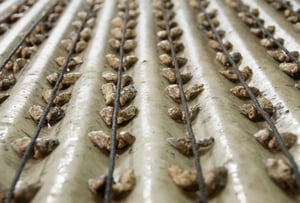 In coastal cities like Baltimore, people take their oysters seriously. Virtually anywhere you go on the eastern coast of the U.S., you can find oyster farms or even the occasional oyster boat that picks up wild-grown oysters and mussels for consumption.
In coastal cities like Baltimore, people take their oysters seriously. Virtually anywhere you go on the eastern coast of the U.S., you can find oyster farms or even the occasional oyster boat that picks up wild-grown oysters and mussels for consumption.
Oyster farming is a surprisingly tough job—one that requires the companies doing the harvesting to carefully monitor oyster populations, as well as water temperature and salinity, to avoid impacting the sustainability of their business. Any kind of contamination in an oyster farming tank could kill growing oysters before they reach maturity, ruining a whole batch of them.
One of the major challenges in the oyster industry is finding the right seafood processing equipment to hold them from the time of initial harvest to the point where they’re ready to be shipped out as a finished food product. Given the weight that some oysters can reach, metal baskets are an obvious choice because of their massive tensile strength. However, the saltwater and other fluids that are incidental to handling oysters can corrode non-resistant metals.
So, how did Marlin Steel make a custom steel wire basket that met an oyster farm’s requirements when they asked for an oyster harvesting basket?
Using Hot-Dipped Galvanized Steel
The big challenge with any custom metal form to be used for any kind of aquaculture application is making sure the metal can survive repeated prolonged exposure to saltwater—whether it’s actual seawater or a carefully-monitored and controlled saltwater solution used in an aquaculture plant/farm. Normally, chlorides (such as salt) can eat away at the surface of metal, causing pitting and corrosion with alarming speed.
One option would be to use grade 316 stainless steel, which is notable for its resistance to chlorides. However, this option wasn’t suitable for the client’s basket budget considering the sheer number of baskets they needed. So, Marlin’s degreed engineers hit upon the idea of using plain steel with a specialized coating to keep the cost of materials down.
But, which coating would be reliable enough to protect a basket through years of use without becoming stripped down by constant abrasion against rough oyster shells? Or, be relatively easy to strip down and reapply when needed?
After investigating numerous coating options, Marlin’s degreed engineers settled on the use of a hot-dip galvanization process to turn the basket into a galvanized steel basket. This coating process would provide an optimum combination of effective protection for the basket thanks to the thickness and lack of porosity while remaining cost-effective and easy to reapply when necessary.
Optimizing Ease of Handling and Storage Space
While the overall design of the wire oyster harvesting basket looked deceptively simple, being a roughly cubic shape that was slightly wider at the top than at the base, some careful engineering work went into making the basket both stackable and easy to carry.
A set of thick, sturdy metal handles was added to the top of the basket to make it easy to carry by hand. However, these handles would not be permanently welded into position. Instead, they were bent around the top of the basket’s frame and allowed to rotate freely. These handles were also bent into an “L” shape so that, when rested against the interior of the basket, they would create a small shelf shape.
When another basket would be placed on top of the handles, they would rest on the shelf so two fully-loaded oyster baskets could be stacked, one atop the other, without harming the oysters they carried. Because the handles had to be strong enough to take the weight of another fully-loaded basket, they (and the top frame they connected to) were made of steel wires nearly twice as thick as those used in most of the rest of the basket.
Why spend this effort on making the baskets stackable? To help the client save space on their production floor! By making it so two baskets could be stacked, Marlin’s degreed engineers cut the amount of floor space the fully-loaded baskets would require in half.
Additionally, if the baskets were empty, the handles could be rotated to the outside to allow dozens of them to nest one inside the other with ease, meaning that the storage space used by empty baskets would be negligible. This helps to minimize the impact of the baskets on the client’s available floor space.
Learn more about seafood processing baskets by downloading the free guide at the link below. Or, contact Marlin Steel today to start a custom seafood basket order.



.gif)


